Over the course of a half-century studying bacterial genetics, Evelyn Witkin solved enough secrets to fill a long and fascinating diary about how DNA, the fundamental material for all life on earth, is damaged and repaired. But it was not enough for her. If Witkin had her way, she said in an interview several years ago, she would have set up a lab in her basement at home when she retired from Rutgers University in 1991 and would still be trying to tease apart Escherichia coli’s remaining mysteries.
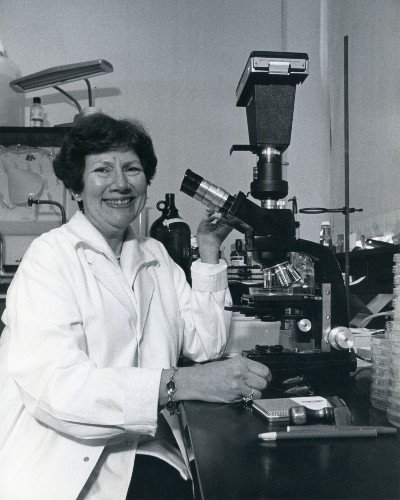
Evelyn Witkin examining bacterial cultures under a microscope
[Courtesy of Special Collections and University Archives, Rutgers University Libraries]
“I used to tell my graduate students that we were really doing cancer research when we were trying to understand mutation and how it works,” Witkin remembers.
“If we understand how mutations are produced and how they’re repaired and how they can be manipulated, we are really dealing with a fundamental aspect of cancer research.”
Luck, Intellect, and Defiance
Looking back on her life and work, Witkin credits luck and chance as playing a big part in how it all unfolded. She was certainly fortunate to grow up in the 1930s with parents who never gave her an inkling that there was anything she could not do because she was a girl. In fact, her stepfather insisted that she and her sister make the grueling early-morning commute from Queens, New York, where they lived, to downtown Manhattan to go to Washington Irving High School, which was an all-girls school and one of the best public high schools around.
By the time Witkin started Washington Irving at the age of 12, she was a voracious consumer of books such as Arrowsmith and Microbe Hunters, and her love of science had firmly taken root. Her teachers at the school encouraged Witkin to consider becoming a scientist herself, just like the characters in Microbe Hunters. Attending an all-girls school was one of her big strokes of luck, Witkin thinks, because the common prejudices about boys being better at science and math did not creep into the educational environment the way they might have in a coed school.
But there is much more to Witkin’s story than can be explained by chance. Whereas Louis Pasteur, a pioneer in the field of microbiology, once said that fortune favors the prepared mind, Witkin is evidence that luck is more likely to go to the enthusiastic and defiant spirit.
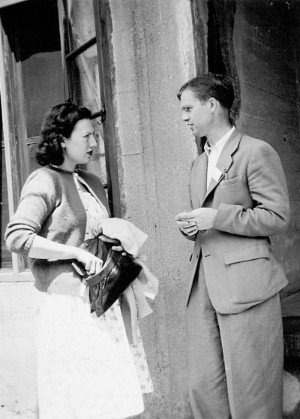
Witkin with AH Sparrow at CSHL in 1947
[Courtesy of Cold Spring Harbor Laboratory (CSHL)]
Choosing a PhD Advisor
Witkin set her sights on the lab of Theodosius Dobzhansky at Columbia. Although he turned out to be the perfect PhD advisor for her, she sought him out for other reasons. As she recounts with a healthy dose of embarrassment, Witkin had become fascinated with genetics after her “very radical” college boyfriend turned her on to scientific articles by a prominent Soviet biologist named Trofim Lysenko, who argued that there was no such thing as genes, and that instead the environment controls the traits we inherit. Witkin was originally drawn to Dobzhansky not because he was a world-renowned geneticist but because he was from Russia and, she hoped, could read Lysenko’s articles in their original language (whereas she had to settle for English translations). It took Witkin only a few months at Columbia to disabuse herself of the ‘no such thing as genes’ notion. Years later, once she had her PhD, she admitted to Dobzhansky her motivation for joining his lab. “I don’t think he ever laughed as loud in his life,” Witkin recounts.
It would be hard to pick the time when Witkin’s unbounded enthusiasm was most beneficial to her. But a case could be made for early in her graduate studies, when she presented an article for a class “jumping up and down with excitement.” as Witkin recalls, because the article demonstrated that bacteria, just like every other creature that had been studied, have genes. Dobzhansky, who was leading the class, took note of her reaction and arranged for Witkin to spend a summer in Cold Spring Harbor learning techniques for working with bacteria. It was a big departure from studying fruit flies, which were the experimental organism of choice at the time for Dobzhansky and other Columbia geneticists.
Ultraviolet Light to Mutate Genes
In her very first experiment at Cold Spring Harbor, Witkin exposed E. coli to ultraviolet light to mutate their genes. It had been known for a couple of decades that radiation can induce mutations in fruit fly genes, but Milislav Demerec, who was overseeing Witkin’s research at Cold Spring Harbor, was trying to get a handle on mutating bacteria. However, Witkin used too high a dose of ultraviolet radiation, and only a few colonies survived on the Petri dish where there had originally been millions. Witkin immediately suspected these stragglers were somehow resistant to radiation, because studying bacterial resistance — to penicillin and other challenges — was scientifically in vogue at the time. She returned to Cold Spring Harbor as soon as she finished her graduate coursework at Columbia in 1945 and dedicated her PhD research to studying the genes that bestowed resistance to radiation.
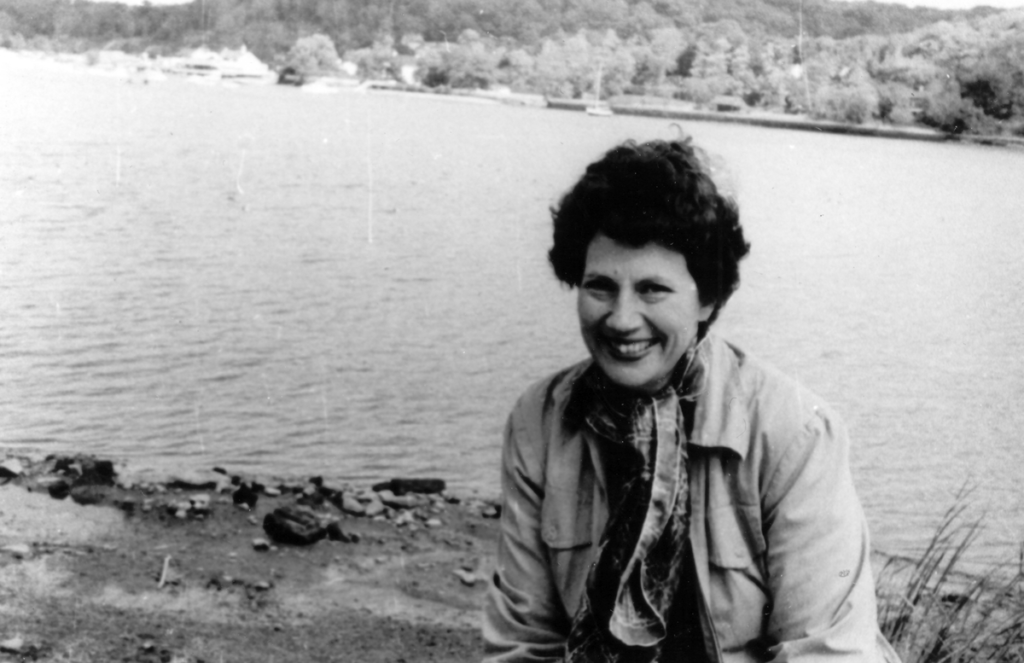
Witkin at Cold Spring Harbor in 1958
[Courtesy of CSHL]
“Every week there was a new discovery that made one gasp,” Witkin recalls. “It was like being on a rollercoaster ride.”
One of her burning questions was what genes are made of. The “prejudice,” Witkin says, was that it had to be proteins because DNA, with only four types of nucleotide building blocks, was just too simple. It took a series of scientific articles between the early 1940s and 1950s to finally convince the leading scientists, including Witkin’s advisors, that genes are made of DNA. That decade, which spanned Witkin’s time at Cold Spring Harbor, culminated in a meeting at the research institution where James Watson, who discovered the structure of DNA along with Francis Crick, Rosalind Franklin, and Maurice Wilkins, revealed their now-famous double helix model. “Just looking at it and hearing him talk answered all the fundamental questions about how the gene works,” Witkin remembers.
Elucidating the Process of Repairing DNA Damage
Toward the end of Witkin’s time at Cold Spring Harbor, she had an unexpected finding that rivaled the excitement of her first experiment there and laid the foundation for her work that would show there is a process to repair DNA damage. She made the surprising observation that the number of mutations that bacteria develop after exposure to radiation depends on the medium on which they are grown: give bacteria plenty of nutrients and they’ll develop ample mutations, but deprive them of nutrients and they’ll have scant mutations. Witkin had a hunch that this odd finding was worth pursuing, a kind of instinct that she has said the best scientists possess.
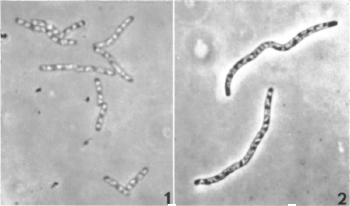
E. coli normally grow as short rods (left), but after irradiation, the bacteria form long filaments (right) because the SOS response stalls cell division.
As she continued her research at the State University of New York (SUNY) in Brooklyn and then at Rutgers University, Witkin also pursued research on the effects of ultraviolet light on E. coli beyond DNA damage, such as how the bacteria are induced to form long filaments. This work dovetailed with the research of Miroslav Radman, who was a post-doc at Harvard University. During her first year at Rutgers in 1971, Radman reached out to Witkin to propose a phenomenon that would end up explaining her surprising observation about the relationship between bacterial growth medium and the number of mutations. He suggested that the radiation triggered an SOS response that caused the bacteria to rush through DNA repair in a way that increases the chance of errors, or mutations.
Here, Witkin’s luck conspired with both her sharp scientific instinct and her open-mindedness, which she has said is an important trait for scientists, to reveal a grander picture of how bacteria respond to insult. Although she was first skeptical of Radman’s idea, she carried out her own experiments that convinced her that bacteria have an error-prone pathway for repairing DNA. Witkin also took the idea of the SOS response further and suggested that it has myriad effects on bacteria. In 1975, she and Radman assembled scientists studying the disparate effects of radiation on bacteria together for a meeting in Florida. By the end of it, she summarizes, everyone agreed that these multifaceted effects were part of the SOS response. “It was the most exciting meeting I have ever been at,” says Witkin, who, lest it be forgotten, was at the meeting when Watson first shared the structure of DNA!
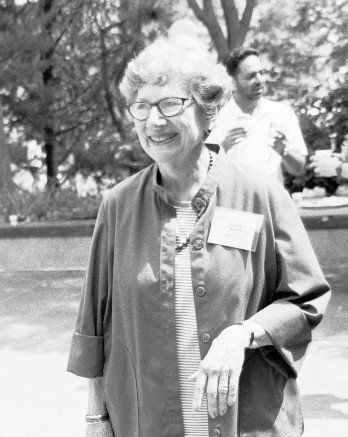
Witkin at Cold Spring Harbor Laboratory in 2000
[Courtesy of CSHL]
In many ways, Witkin’s personal life was marked by the same good fortune as her professional one. Around the time she was installed at Cold Spring Harbor, her husband, Herman Witkin, got a job in the psychology department at Brooklyn College, after doing research in Texas and serving in the army during World War II. Although he would have to do his own grueling commute from Long Island for about 10 years, the couple could be together.
Witkin avoided many of the challenges that are barriers to women in science, even to this day. When she and Herman were expecting their first child, she asked Vannevar Bush, who oversaw the genetics department at Cold Spring Harbor, if she could take a leave of absence. Bush sympathized with the challenges that women face in trying to balance scientific careers and family and asked her how he could make it work for her. “This was an extraordinary attitude to encounter at that time. It would still be unusual in the 21st century,” Witkin recalls. She went on to work part-time until both of her sons finished high school.
Looking back at how much Witkin has contributed to genetics and our understanding of life, it is hard to imagine that she might have instead focused on poetry, her other great intellectual love. She has returned to this second focus since her retirement and made contributions to our understanding of how the worlds of Robert Browning, a preeminent Victorian poet, and Charles Darwin, father of evolution, intersected and might have influenced each other. It is easy to see how enthusiasts of science and the natural world will be looking back and learning from the life of Evelyn Witkin for years to come.
By Carina Storrs
